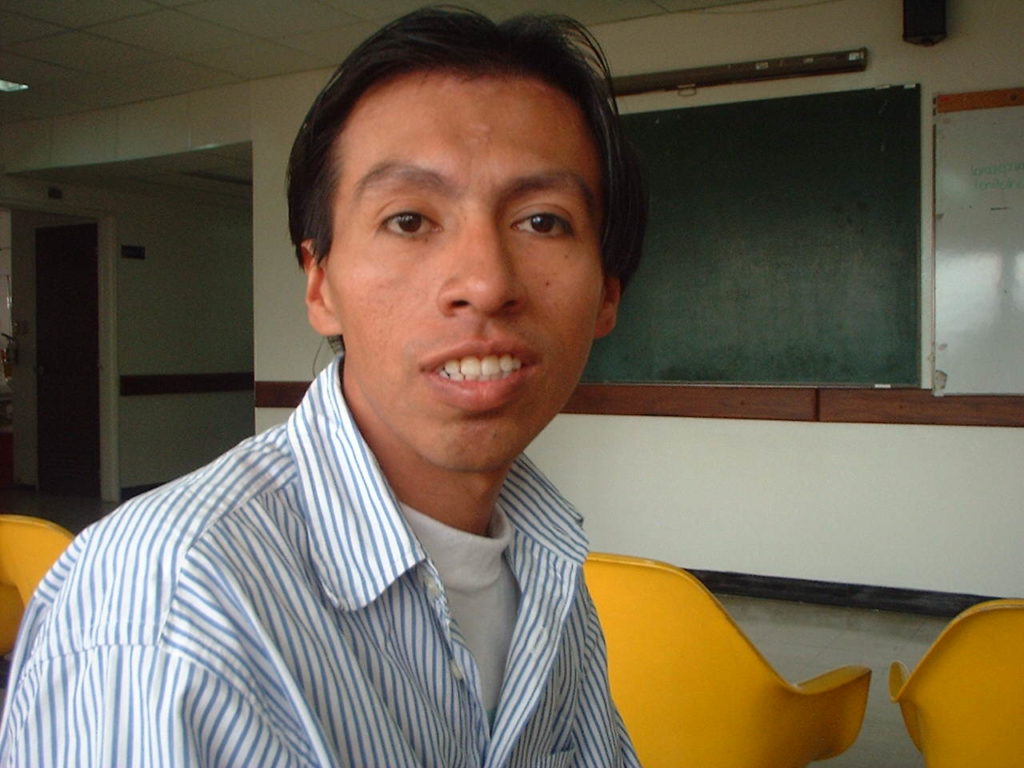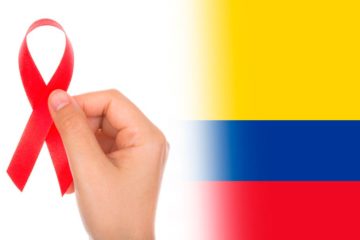
Fernando Hernández nunca olvidará el 24 de noviembre de 2003. Eso es el día en que su prueba de sangre volvió positiva. Se encuentra en el Hospital Público Simón Bolívar de Bogotá en noviembre del 2004. (Foto por Patricia Nazario)
As the 30-year-old recounts what happened, he sits on his hospital bed at Bogota’s Simon Bolivar Public Hospital. This is where the capital’s first-known AIDS patient was treated in 1985. The level of care is well respected. Doctors in the AIDS ward consider themselves experts and take pride in knowing they’ve treated more HIV-positive patients than any hospital in the country.
Yet Colombia has a big–and growing–problem. Brazil leads the region by far in HIV infection cases reported, at 660,000. But Colombia is at 190,000–ahead of much larger Mexico and with a fraction of the population of either country. One in 238 Colombians has HIV, while 1 in 280 Brazilians is reported to have the disease. HIV is the second-leading cause of death in Bogota–after violence.

Fernando Hernández con su máma, María Elena Hernández en la sala de espera de Hospital Público Simón Bolívar de Bogotá en el noviembre del 2004. (Foto: por Patricia Nazario)
An estimated 1.6 million people are living with HIV across the Caribbean and Latin America, according to the United Nations, and the region’s mortality rate is third behind sub-Saharan Africa and Asia. Colombia’s epidemic is still growing in Bogota, but spreading twice as fast along the Caribbean coast. There, it’s mainly affecting women, experts say, thanks to prostitution and promiscuity.
The economics of AIDS treatment is tricky enough in developed economies. In places like Colombia, it turns absurd. Antiretroviral cocktails cost US$900 a month while a basic monthly salary is $150. Colombian law protects the medical needs of all HIV patients. But activists at the Joint United Nations Program on HIV/AIDS in Colombia say there’s a huge difference between law and reality.
“The healthcare system covers about 56% of the population. The others don’t have insurance and the state’s responsibility is to treat them at public hospitals,” says Ricardo Garcia, the program’s national advisor. “But the public hospitals are nearly bankrupt and access to anti-viral medications for the uninsured depends on the budget of local governments. Most don’t always have the resources.”
AIDS advocates, meanwhile, say the government won’t investigate corruption at private-but-regulated healthcare providers, known as an entidades promotoras de salud (EPS). “Dozens of formal complaints have been filed with the authorities with proof that EPSs are refusing HIV medications to patients,” says Mauricio Sarmiento, an HIV patient, and publisher of Indetectable, a free, Spanish-language magazine covering the disease. “They say, ‘Our inventory ran out. Come back in two weeks.’ The EPS’s save hundreds of dollars every day they deprive people of their medications, and sometimes they do it by the thousands.”
The fight against AIDS is on the right track, says Carlos Hernandez, a doctor who manages HIV/AIDS programs for the private-public social security system. Compared to other countries in the region, Hernandez says, Colombia has made several accomplishments. There’s access to healthcare, antiretroviral drugs, he says, and an AIDS law that details the rights and obligations of people living with the virus. “The healthcare system includes HIV blood tests and allows anyone with AIDS to retire and draw a pension,” Hernandez says. “There are still countries in Latin America that don’t even have access to medications, by law.” Moving on. Leaving the hospital, Fernando Hernandez says he’ll do his part to control the epidemic. He’s just starting his antiretroviral cocktails and hopes the daily combination of three small pills will help him regain some of the more than nine kilograms he’s lost. He’s ready to move on with life.
Along with his parents, Hernandez takes a bus home to Patio Bonito, a working-class neighborhood in Bogotá with dirt roads, dilapidated buildings and tin roofs. Before his diagnosis, Hernandez had worked as a surgery assistant at a hospital. He quit because a compromised immune system could make him more susceptible to catching diseases. Now he’s out of a steady paycheck and faced with expensive medical bills and combination antiretroviral therapy. “If I can make low monthly payments,” he says, “I should be able to do it with help from my family.”
People living with HIV infection in Latin America in 2004:
(In thousands)
-
- Brazil: 660
-
- Colombia: 190
-
- Mexico: 160
-
- Argentina: 130
-
- Venezuela: 110
-
- Peru: 82
-
- Guatemala: 78
-
- Honduras: 63
-
- El Salvador: 29
-
- Chile: 26
-
- Ecuador: 21
-
- Panama: 16
-
- Paraguay: 15
-
- Costa Rica: 12
-
- Nicaragua: 6
-
- Uruguay: 6
-
- Suriname: 5
-
- Belize: 4
-
- Bolivia: 5
SOURCE: United Nations
Reprinted from web.archive.org.


